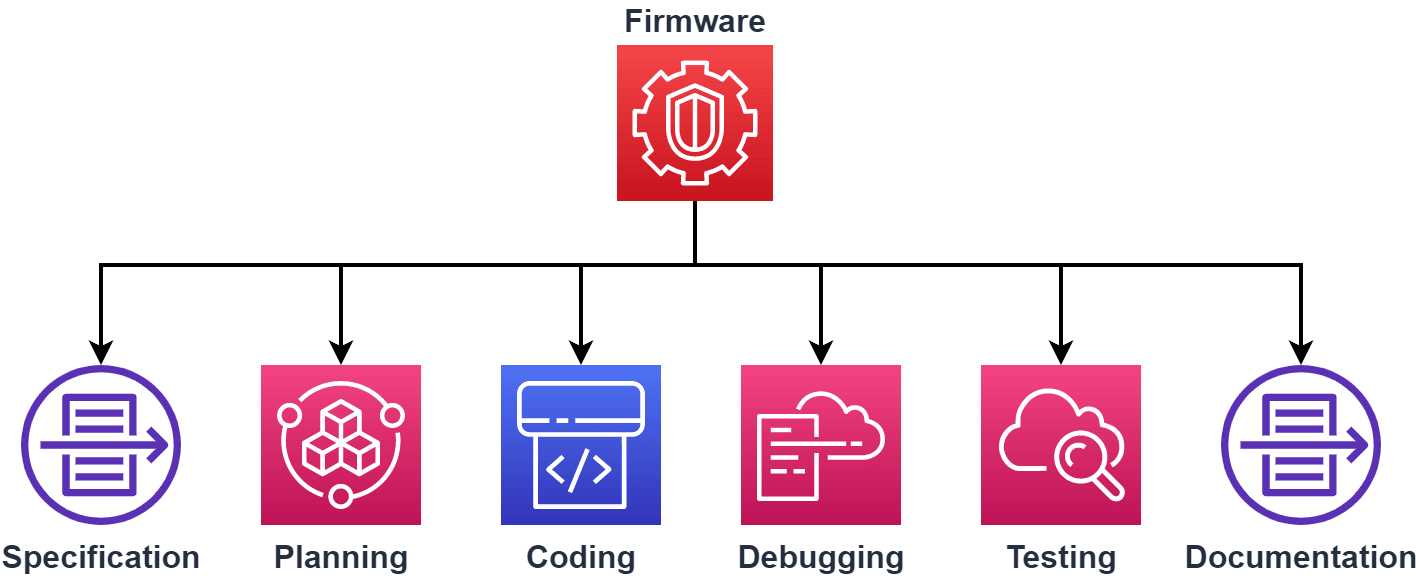1. 概述
在本教程中,我们将介绍固件和操作系统的概念,并深入探讨它们之间的核心差异。
固件与操作系统都属于软件的范畴,但它们在功能、使用场景以及开发流程上有显著区别。了解这些差异对于理解系统底层运行机制、进行嵌入式开发或系统架构设计都非常有帮助。
2. 固件简介
固件(Firmware)是一种特殊的计算机软件,它包含针对特定硬件设备的底层指令集。固件的作用是帮助硬件正常工作,并与其他硬件和软件进行通信。
通常,固件被固化在硬件的特定区域中(如ROM、Flash存储器),并作为硬件运行的“指南”。例如,计算机的BIOS就是典型的固件之一,它包含了系统启动所需的基本功能,是操作系统启动的基础。
许多设备如相机、灶具、冰箱、电子设备等都需要固件。当用户发出指令时,这些设备中的固件会根据预设的程序执行相应的操作。因此,固件既可以用于电子设备,也可以用于计算设备。在一些简单的系统中,固件甚至可以充当操作系统。
固件执行的是较为基础的操作,通常使用低级语言(如汇编)编写,专注于控制特定硬件部分,功能相对固定,不同硬件可能使用不同的固件代码。
3. 固件的开发流程
固件的开发过程通常包括六个阶段:

需求定义(Specification)
这是固件开发的第一步,主要明确微控制器需要满足的标准、目标和功能要求。
固件应具备确定性、可预测性、安全性、可靠性、可复用性等特点。
在涉及安全关键系统的开发中(如汽车ECU、碰撞检测系统),必须遵循如ISO 26262、MISRA C等编码规范,以确保固件的安全性和性能。规划(Planning)
在使用实时操作系统(RTOS)进行调度时,线程执行可能会改变嵌入式单元的寄存器值,从而影响固件的性能。
因此,RTOS调度器的设计和开发计划必须非常严谨,确保软件设计按时完成。编码(Coding)
当前,C语言是嵌入式开发中最广泛使用的语言。
开发过程中可借助仿真(Simulation)、模拟器(Emulator)、FPGA或虚拟平台进行验证。
但由于协同开发的复杂性,往往需要更多投入。代码复用(Code Reuse)
随着固件复杂度的提升和市场对产品上线时间的要求越来越紧,代码复用在固件开发中变得尤为重要。
一个设计良好的硬件抽象层(HAL)可以提供可复用和可移植的代码,从而降低成本和缺陷率。调试(Debugging)
调试通常使用硬件模拟器和汇编器进行,大多数情况下会借助集成开发环境(IDE)完成。
可以使用内置的模拟器配合软件仿真来模拟微控制器(如ARM Cortex-M)中的内存读写操作。文档与版本控制(Documentation & Version Control)
正确的源代码注释对于代码复用至关重要。
Doxygen 是常用的文档生成工具,可以从源码中提取技术文档。
当代码仓库中存在多个版本时,应使用版本控制系统(如Git)确保使用的是正确的代码版本。
✅ 踩坑提醒:不规范的注释和缺乏文档管理会导致后期维护成本剧增,建议从项目初期就建立良好的注释和文档体系。
4. 操作系统简介
操作系统(Operating System, OS)是计算机中最复杂的软件之一。它的核心功能包括:
- 允许多个用户和进程共享CPU资源
- 保护数据不被未经授权的访问
- 确保各种输入输出设备正常运行
操作系统通过复杂的硬件指令,为用户提供高级服务。各种软件程序在处理器上运行以完成用户任务。但实际上,CPU无法同时执行操作系统和应用程序。
因此,系统设计中必须设置机制,确保应用程序执行后,操作系统能够重新获得控制权。这种“服务与硬件之间的功能差距”使得操作系统变得强大且复杂,它能在极其底层的硬件基础上提供高级服务。
操作系统的组成
通常,操作系统由以下8个核心组件构成:

- 进程管理:管理正在运行的程序及其资源(如内存、CPU)
- I/O管理:负责输入输出设备的操作,隐藏硬件细节
- 文件管理:创建和管理文件及目录,将文件映射到二级存储
- 网络管理:处理网络通信、安全和维护
- 内存管理:分配和释放内存空间
- 二级存储管理:作为主存的备份
- 安全管理:控制内存访问权限
- 命令解释器系统:提供用户与系统的交互接口
5. 操作系统的设计目标
现代操作系统在设计时需满足多个关键目标:
- ✅ 资源共享:多用户、多进程共享硬件资源
- ✅ 安全性:保护用户数据和隐私
- ✅ 并发性:支持多核架构,实现多任务并行
- ✅ 可移植性:能在不同硬件平台上运行
- ✅ 可扩展性:支持硬件或软件的灵活扩展
- ✅ 向后兼容:支持旧系统的功能和接口
⚠️ 设计难点:如何在多核架构下实现高效并发处理,是现代操作系统面临的主要挑战之一。
6. 固件与操作系统的区别总结
| 对比维度 | 固件(Firmware) | 操作系统(Operating System) |
|---|---|---|
| 所属层级 | 嵌入在特定硬件中的软件 | 用户与系统之间的桥梁 |
| 存储方式 | 一般存放在非易失性存储器(如ROM) | 存放在硬盘或SSD中 |
| 编程语言 | 主要使用汇编或C语言 | 多使用C/C++编写 |
| 控制对象 | 控制特定硬件模块 | 管理整个系统的多个组件 |
| 可修改性 | 不可修改或极难修改 | 用户可灵活修改功能 |
| 功能级别 | 执行低级操作(如硬件初始化) | 执行高级操作(如多任务、GUI) |
| 应用场景 | 路由器、显卡、键盘、洗衣机等 | Windows、Linux、macOS等 |
| 程序类型 | 单一用途程序 | 多用途程序 |
| 程序大小 | 通常较小 | 通常非常庞大 |
| 更新频率 | 一旦开发完成很少更新 | 需要定期更新 |
7. 总结
在本教程中,我们介绍了固件与操作系统的基本概念,并对比了它们在功能、结构、开发流程等方面的区别。
- 固件更偏向于底层硬件控制,功能固定,开发流程严谨
- 操作系统则更注重资源管理和用户交互,功能丰富,结构复杂
理解这两者的区别,有助于我们在开发嵌入式系统、操作系统或进行系统优化时做出更合适的技术选型。
✅ 建议:如果你是系统开发人员或嵌入式工程师,建议深入了解固件开发流程和操作系统内核机制,这对提升系统稳定性与性能非常有帮助。